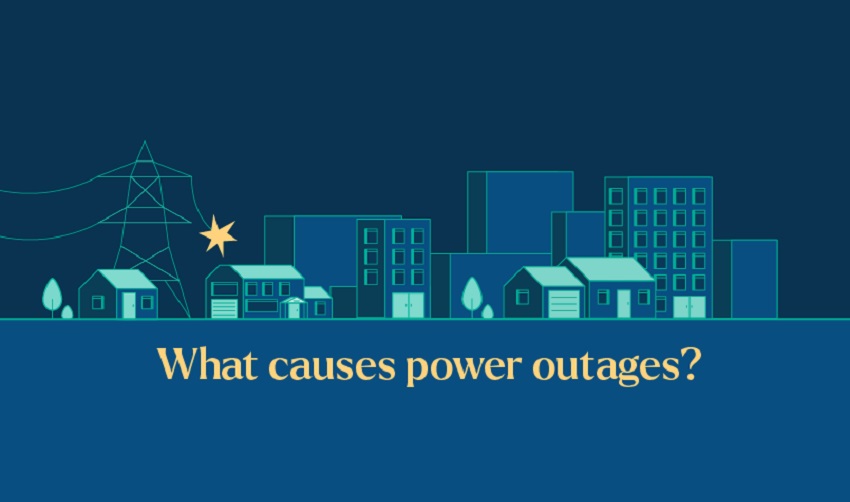Causes of Power Outages

A power outage can interrupt critical business operations, resulting in lost productivity. This is especially true when an outage lasts for days or more.
The good news is that most of the causes of power outages are preventable. From balloons entangled in power lines to mischievous squirrels foraging inside substation equipment, there are many different reasons why our electric grid experiences outages regularly.
Falling Trees and Branches
Power outages sometimes happen when there is too much demand on the electricity grid. For example, homes and businesses using a lot of energy operating air conditioners can overburden the system. This can cause overheating in transformers and other equipment, leading to a short circuit and an outage.
More often, though, outages are caused by trees or branches contacting power lines. During storms and periods of high winds, dying or weak tree limbs can snap and come into contact with lines or poles. In other cases, trees planted too close to power lines can also interfere with them. All new trees should be planted far enough away from power lines that they won’t be affected by them in the future.
Vehicle collisions with utility poles also cause outages. A momentary lapse of attention or driver impairment can result in a car or truck skidding into a pole and knocking it down. Fortunately, this kind of incident rarely affects a wide area and is often repaired relatively quickly.
Other natural causes of power outages include wildfires that burn through power lines, earthquakes that upend lines, and floods that wash them away. Less frequently, mudslides and tidal waves can also disrupt the electricity grid. A tracker for a Texas power outage generally needs to make more substantial repairs in reaction to these occurrences.
Wildlife
Animals cause power outages by contacting overhead lines while foraging, building their nests, or walking or running into them. Birds often cause outages when they fly into or land on lines or equipment.
Squirrels are the biggest culprits, accounting for about half of all outages caused by animals in a given year. But other pesky critters like rodents, raccoons, snakes, and insects can also interfere with lines. Squirrels can short-circuit cords by climbing into substations and other electrical equipment. This problem is exacerbated by their ability to remember the best spots to hide and cache food.
Birds also often cause outages by flying into lines intentionally or inadvertently. In some cases, the acidic droppings of birds can corrode expensive hardware and short-circuit connections.
The good news is that many of these animal-related issues can be avoided by using products and techniques that prevent animals from accessing energized parts of the system. Other utility companies use various tools, including disks that fit around insulators to keep animals from touching them. Some utilities also use special fencing and “critter guards” to deter animals from entering areas where they shouldn’t be.
Motor Vehicle Accidents
One of the more common reasons for power outages is when a vehicle collides with a utility pole. Whether the driver is impaired or simply experiencing a momentary lapse of attention, this type of accident can destroy the pole and disrupt customer power flow. This outage typically affects a small area and is restored relatively quickly.
Construction work can also cause outages, significantly when earthmoving equipment cuts through underground cables or knocks down power lines.
Weather is another leading cause of power outages, from lightning that strikes and cuts through lines to heavy winds that damage transformers and other electrical equipment. Floods, mudslides, and volcanic eruptions can damage or destroy power infrastructure. During severe weather, it’s always wise to reduce your energy consumption and have an alternate plan in case your home loses power. This is particularly important for people with medical conditions that require refrigeration and those who depend on power-dependent medical equipment.
Winds
From tree-trimming efforts gone awry to wild wind storms, winds can cause damage to lines and poles that carry electricity to your home. High winds can blow limbs and branches from trees onto power lines, while heavy snow or ice can weigh down trees and cause them to snap. These power outages typically only affect a small area and are often quickly restored.
Other weather-related causes of power outages include extreme temperatures, which can cause lines, cables, and transformers to overheat or short-circuit. These outages are most common during peak energy usage, such as afternoons during heat waves.
While most people don’t realize it, these minor faults happen daily and are the main reason the grid experiences intermittent outages. A permanent fault is a simple issue requiring someone to go out and repair the problem, so these outages typically don’t last very long. A brownout is a more serious issue and happens when the system is overloaded. In the worst-case scenario, this can lead to a blackout lasting for weeks in extensive areas.
